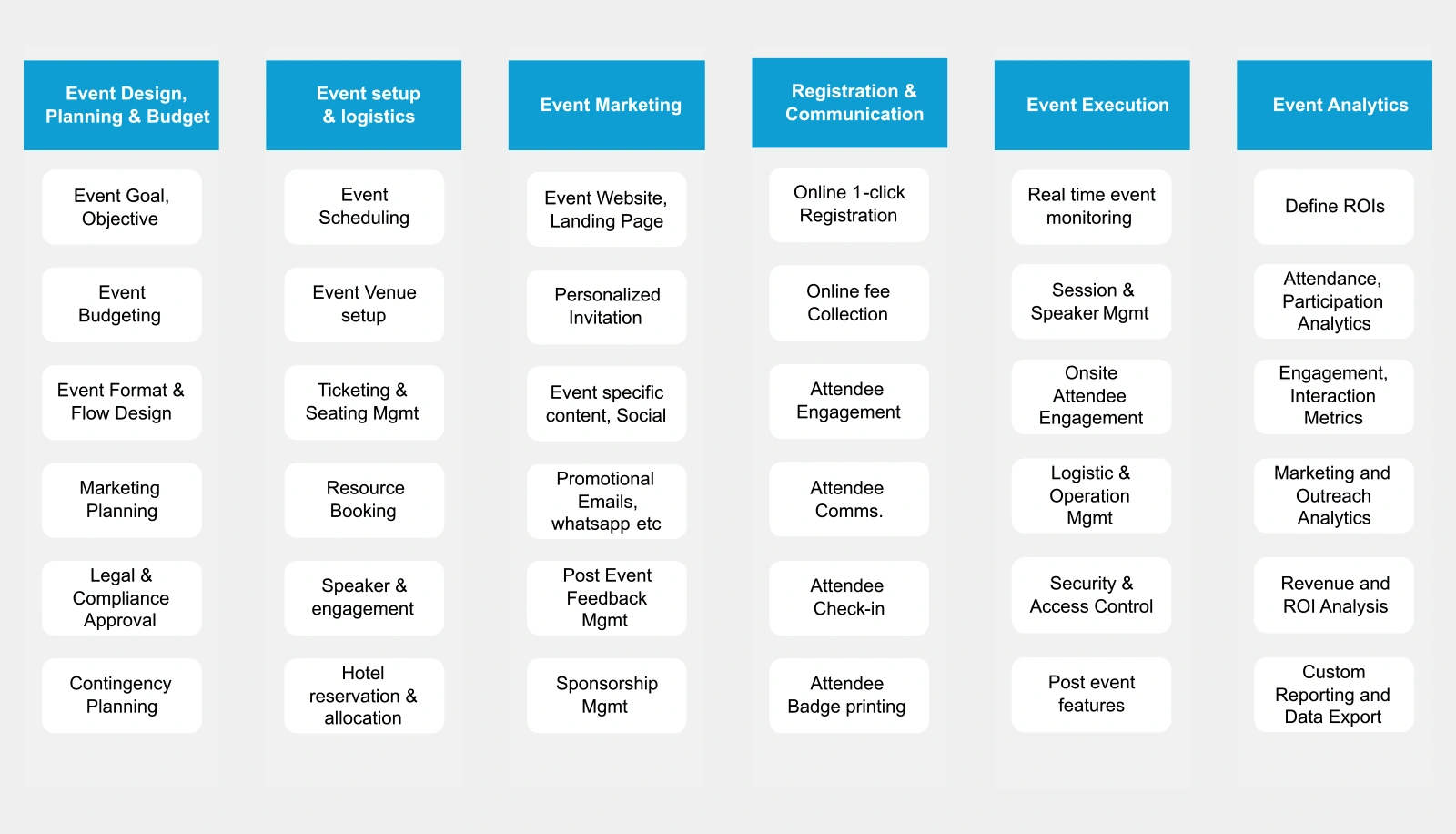- Posted on : November 20, 2024
-
- Industry : Corporate
- Tech Focus : Digital Experience Platform
- Type: Blog

For a B2B business, it is essential to understand the importance of physical or virtual events like webinars. These help them achieve various goals, such as lead generation, brand awareness creation, new product or service launch promotion, customer engagement and retention, or simply educating and training customers about their offerings.
The diagram below shows a quick list of objectives an event management platform can address.

End-to-end Event Marketing with Microsoft Dynamics 365 Customer Insights
Microsoft Dynamics 365 Customer Insights is an evolution of the MS Dynamics 365 Marketing module. The Event Management sub-module was also present in Dynamics 365 CRM. However, it has now evolved with more comprehensive event-related features, pre-configured dashboards, MS Team integration, etc.
To start with, let us list the key features of event management—be it live events or webinars. The features are divided into six high-level categories that constitute the event process flow—starting from planning, setup, marketing, execution, and analytics.

Setting up and configuring Microsoft Dynamics 365 Customer Insights
Before we go further, it may be worth looking at the OOTB data model available with the MS Dynamics 365 Customer Insights—Data solution. Please note that these are only the key objects and not all objects. The relationships described here are perceived from a specific implementation and could change a bit based on customer requirements. This article lists all entities if anyone wants a comprehensive list. This is part of the Microsoft Common Data Model.
Using the OOTB entities, below is a data model we built, which can be used as a starting point for such event management implementation. Please note how the entities are related, i.e., one-to-one, one-to-many, many-to-many, etc., for a standard implementation. As mentioned earlier, they may change based on the customer’s requirements, though the basic requirements will remain the same. As an example, an event will always have a venue(one-to-one), but that venue may span across multiple buildings (one-to-many) and potentially multiple rooms (many-to-many with buildings), whereas each room would have only one layout (one-to-one with room) and so on.

After the data model finalization, the next obvious question is what the architecture may look like. It is important to notice that, primarily, the persistence layer required for the module will be supplied by MS Dynamics CRM and its Event module, while various portals like marketing, registrations, speaker nominations, etc. will be built using Power Pages. Marketing communications will be handled primarily through MS Dynamics Customer Insights Journey. Power automation helps automate workflows required for external integration, such as hotel booking, venue management, print service, etc. The diagram below depicts a high-level functional architecture.

Once these initial architectural and design decisions are achieved, the focus is on configuring the initial setup and subsequent regular configuration for specific events.
After the successful implementation of the event management module, it is essential to know its effectiveness in B2B marketing, where a comprehensive event management dashboard can help a lot. Below is a screenshot of such a dashboard focusing on social. (Reference: Event Management for Dynamics 365)
And for a specific user, this is how the dashboard looks like:
Key Benefits
From 360-degree event support to powerful analytics, Microsoft Dynamics 365 Event Management Customer Insights helps B2B marketing teams accelerate their marketing success. Here is a quick look at some of the benefits we have experienced while implementing it.
- Support across formats and teams. It supports virtual, physical, and hybrid events. Both sales and marketing teams can leverage the benefits of D365.
- Powerful analytics. Integrated sales and marketing analytics help generate crucial insights, drive customer interactions, and improve RoI measurement.
- The platform is compliant with various security regulations and regulatory guidelines.
- Seamless connection. It integrates seamlessly with other Dynamics modules.
- Comprehensive data architecture. This provides 80% of all standard business function objects. It further allows the provision to build custom objects and offers significant scalability.
In conclusion
As businesses look to create the next generation digital experiences for their customers, they are increasingly looking for platforms like Microsoft Dynamics 365 Event Management. This trend will likely continue to evolve and I am excited to see how this landscape evolves and how we can keep helping our clients transform their businesses.
Further reading:
Various step by step guides are available for setting up D365. You can check these out here.






